Ireland is home to more than two hundred ancient stone crosses that were carved prior to the year 1200 CE. The most comprehensive catalogue of these crosses was published in 1992 by Dr. Peter Harbison. This three volume work is titled: The High Crosses of Ireland: An Iconographical and Photographic Survey. A subset of these crosses, referred to as “Scripture Crosses” have scenes from the Bible carved on them. One of these Scripture Crosses is located at the old monastic site of Durrow, in County Offaly. That cross is the subject of this essay.
The scripture crosses of Ireland, crosses with illustrations of various biblical stories, have often been described as the Bible in stone for those who were illiterate. This they were, but they are much more besides. As Francoise Henry, author of Irish High Crosses and a well known, mid-twentieth century scholar of Irish art has written: The scenes are generally “not chosen as realistic representations of an event, but essentially for their inner significance, either as ‘types’ or ‘prefigurations’ of an event in the life of Christ.” (Henry p. 35) They also serve as reminders of the “help of God.” An explanation of the help of God can be found on page 4. The images were more than educational, they were also aids to prayer and meditation.
In this essay we will explore both the biblical themes presented on the Durrow cross and ways in which these themes might have been understood and utilized as aids in prayer and meditation. For each image, I will offer an identification, provide one or more scriptures the scene may suggest, describe the scene as it appears on the cross, provide a visual image, and offer some interpretation that may provide a focus for prayer and meditation. Beyond that I will suggest possible themes for each side of the cross and for the cross as a whole, the iconographic program.
In seeking an iconographic program on a particular cross we ask, Are there certain themes that are suggested by multiple biblical scenes, or for that matter on particular sides of a scripture cross, or indeed on the cross as a whole? For example, as we will see later, the west face of the Durrow cross concerns itself with the Passion and Resurrection narratives of the Christian gospels.
All of the photographs in this paper are from Harbison, Peter, The High Crosses of Ireland: An Iconographical and Photographic Survey. 1992, Vol. 2 Figs. 247-258. All have been cropped.
We will begin with the east face of the cross.
East Face
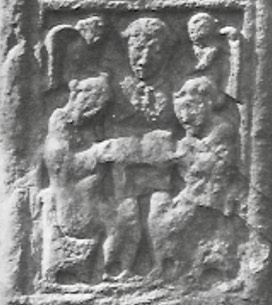
E 1: The Raised Christ or the Mission to the Apostles
Text: No text is related to the Raised Christ; Matthew 28:16-20 may relate to the Mission to the Apostles. This text is generally known as the Great Commission.
In the image to the right we have a central figure in the upper center of the frame. On each side of this figure’s head there is an angel. Below each angel there is a seated figure. These seated figures face each other, flanking the lower torso and legs of the central figure, and they hold a book between them.
The central figure is interpreted as the Risen Christ. This figure is recognized as risen by the presence of angels on each side of his head. The two other figures may represent the apostles Peter and Paul, or simply two apostles, and the book they hold is the Gospels. If this represents the ancient image of the Risen Christ alone, the figures, by tradition, are probably Peter and Paul. If it represents the Mission to the Apostles, it would typically show at least three apostles. In this case there are only two. If this is the Mission to the Apostles, the Risen Christ is giving the apostles the Great Commission. This command of Christ has two parts. He sends the apostles out to “teach” and “baptize.” The teaching calls those who hear the Good News to believe. Baptism is a sign of entry into the faith community that is called to fulfill the Great Commission. The idea of the ongoing work of Jesus’ followers in sharing the Good News is valid whether the image was intended to represent simply the Risen Christ or the Mission to the Apostles.
M. Eugene Boring, author of a commentary on the Gospel of Matthew, points out that doubt was part of the experience of the disciples. It was a “worshiping/wavering community of disciples to whom the world mission is entrusted. (Boring, p. 503) Jesus begins his address to the disciples by claiming “all authority in heaven and on earth.” (Mt. 28:18b) Thus his resurrection is also his enthronement. The message is to be taken to “all nations” including Israel but no longer limited to Israel. The disciples are to teach and baptize. “Baptism is the act marking a transition from outside the Christian community to discipleship within it.” (Boring, p. 504) What is implied is that keeping Jesus’ teachings will be “the sole criterion on the last day.” (Boring, p. 504)
Reflection
Each of us who have become part of the Christian community might ask: a) What the Good News means to us that we have responded in faith; b) What our baptism means to us and how we are living in the community of faith; c) How we are taking responsibility to live out the Great Commission.
E 3: The Sacrifice of Isaac
Text: Genesis 22:1-19
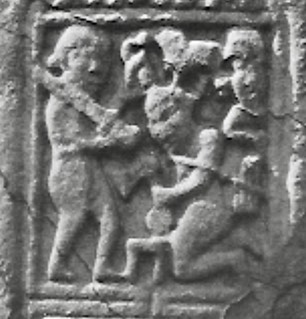
In the image to the right we see Abraham on the left with a sword in one hand and fire in the other. Isaac is on the right, one knee on the ground. He holds an ax and carries the wood for the sacrificial fire. Above him are an angel, upper right, and the ram, just above Isaac’s head that will become the actual sacrifice.
This scene can be interpreted in a number of ways. Francoise Henry wrote: “This one scene — the sacrifice of Isaac by his father Abraham — can appear as having at least three different interpretations: either Isaac can represent the faithful saved from death by God, or he can be a prefigure of Christ carrying his cross, or his sacrifice by Abraham can be a prototype of Christ, and consequently of the sacrifice of the mass.” (Henry, p. 38)
Or, to add an additional possible interpretation, this text can remind us of resurrection, specifically the resurrection of Christ. Terence E. Fretheim, author of a commentary on the Book of Genesis, states that “Israelite ritual regarding the firstborn informs this text. Israel knew that God could require the firstborn (Exod 22:29), but that God had provided for their redemption (Exod 13:13; 34:20). Here, God does just this: God asks that Isaac be sacrificed and provides an animal ‘instead of’ Isaac.” (Fretheim p. 494) The faith that God would find a way to give back that which was sacrificed links this text to the resurrection. This theme is given expression in the book of Hebrews 11:17-19.
17 By faith Abraham, when put to the test, offered up Isaac. He who had received the promises was ready to offer up his only son, 18 of whom he had been told, "It is through Isaac that descendants shall be named for you." 19 He considered the fact that God is able even to raise someone from the dead—and figuratively speaking, he did receive him back.
Reflection
With several possible interpretations of this text and image, does one or the other speak to you today? Do you have an additional interpretation? How have you typically interpreted this story?
Excursus on the “help of God.”
By at least 800 CE, various forms of the “prayer for the dying” were present in Ireland. This was a formula prayer that asked God’s help by reciting examples from the Hebrew scriptures where the faithful were saved. Examples include God delivering Noah from the flood, Isaac from sacrifice, the Three Children from the fiery furnace and Daniel from the lions. A form of this prayer in Ireland was part of the Martyrology of Oengus-the-Culdee. Related to the Sacrifice of Isaac, the prayer read:
Free me, O Jesus,
Into thy many-graced heaven
As thou savedst Isaac
From his father’s hand.
(Henry, pp. 36-37)
South Arm: David playing his harp.
Text: 1 Samuel: 16:14-23
In the image to the right we see the figure of David siting in a low chair, holding his harp in front of him and presumably playing.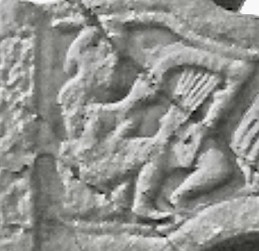
This scene can also be interpreted in a variety of ways. It can refer to King David as a prefiguration of Christ simply because Jesus was descended from David. Or, it can be interpreted as a scene representing the help of God because David’s playing relieved the suffering of King Saul from what was described as an “evil spirit.” In this same vein, the scene could remind us of the promise of the Risen Christ to his disciples in the Gospel of John (14:27) “Peace I leave with you; my peace I give to you. I do not give to you as the world gives. Do not let your hearts be troubled, and do not let them be afraid.”
There is another interpretation as well. In 1 Samuel, David is introduced into the household of King Saul. The reader knows (1 Sam. 16:11-13) that Samuel has already anointed David king. The text tells us that “the spirit of the Lord came mightily upon David from that day forward.” In the very next verse we are told that “the Spirit of the Lord departed from Saul, and an evil spirit from the Lord tormented him.” In the act of anointing, David is given authority that he will later exercise. When we recall that Jesus was a son of David and filled with the Holy Spirit, this simple scene reminds us again that the Risen Christ has inherited this authority. Or, put the other way round, that David prefigures the Spirit-given authority of the Christ.
From the point of view of monastic Ireland, David playing the harp is a reminder of the Psalms, many of which are attributed to David. In the course of each day of worship and prayer, the Psalms were a constant presence for the monks.
Reflection
Which of these possible interpretations speaks to you today? Do you have an additional interpretation?
North Arm: David Slays the Lion
Text: I Samuel 18:34-35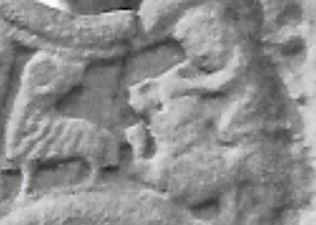
In this scripture David does not actually slay a lion. Instead he tells of doing so to convince King Saul that he is capable of facing Goliath.
In the image to the right we see the figure of David astride the back of a lion and pulling its jaws apart. In front of the lion is a sheep, representative of the flock David was protecting.
This scene can be interpreted as prefiguring Christ’s act of salvation, and therefore, the help of God. As David saved the flock, so Christ saved humanity. This interpretation can be extended. Because of the connection of the killing of the lion with the killing of Goliath, an event that saved the Hebrew people, this can also be seen as a reference to that event, which once more prefigures Christ as savior.
Reflection
Recall some times when you were helped out of a difficult situation through the help of another person. Do you ever think of that as the “help of God?” What does salvation through Christ mean to you?
Center of the Head: The Last Judgment
Text: Matthew 25:31-34, 41 and 46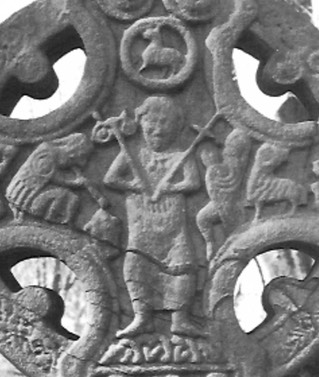
In the image to the right we see the figure of Christ in the center. In his left hand is a cross and in his right hand a scepter that flowers at the upper end. Above Christ’s head is the image of the lamb in a circle. Christ stands on interlace that may represent clouds. On the right of Christ is the figure of an angel that appears to pray or praise. On the left of Christ another angel plays a pipe. At the end of the pipe is the figure of a human head.
The cross and scepter are signs of Christ’s authority. The lamb above is representative of Christ as the “lamb of God who takes away the sins of the world.” (John 1:29) In the early church the lamb was a symbol for Christ as both suffering and triumphant. In this image it likely represents the triumph of Christ over sin and death. Angels often accompany Christ in images of the Crucifixion and the Last Judgment. Here, with Christ depicted standing on a cloud, the presence of angels is particularly appropriate. Below the pipe, of the angel on the left, there appears to be a head. This may reflect that judgment is taking place. Christ, according to our text, judges people according to their actions in life.
Reflection
What is your inner response to the idea of the Last Judgment? Do you see yourself as a sheep or a goat? Do you expect Christ to judge you more harshly or less harshly than you judge yourself? How might you pray to the Lamb of God or to Christ as Judge?
Themes of the East Face
This side of the cross can be read as representing the resurrection and authority of Christ. In the Risen Christ or Mission to the Apostles, the Risen Christ begins addressing the apostles by saying “All authority in heaven and on earth has been given to me.” His instructions to his apostles are given as an expression of this authority, which he has as a result of his crucifixion and resurrection. The image of the Sacrifice of Isaac higher on the shaft underlines the reality of the cross while also pointing to the resurrection. When Jesus laid down his life, he received it back through resurrection and gained “all authority.” These first two images point to the image in the center of the head of the cross of the Last Judgment. It is the Risen Christ, the Lamb of God, exercising his authority who will, in the words of Matthew 25:31-45, separate the sheep and the goats. The images of David on the arms of the east face also point to the authority of Christ. The David who enters the court of Saul has already been anointed by Samuel. The David who claims to have killed a lion saves the Hebrew people from their enemies. David prefigures the authority of the Christ.
South Side
S 1: Eve Gives the Apple to Adam
Text: Genesis 3:1-7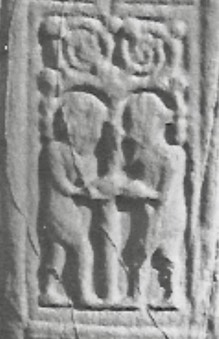
In the photo to the right we see Adam and Eve standing below the forbidden tree. The serpent can hardly be seen, but is present. We see Eve giving the apple to Adam.
The story of Adam and Eve eating from the tree of the Knowledge of Good and Evil has long been seen as the act of disobedience that caused a breach between humans and God. Thus, sin was introduced into the world. This image, at the same time, points to Christ. Christ is described as the second Adam twice in scripture. This occurs in Romans 5:12-21 and I Corinthians 15:22 & 45. As sin, and death, was brought into the world through the disobedience of Adam and Eve, reconciliation with God and life eternal is brought through the obedience of Christ.
Reflection
What is “sin”? Is it inevitable for us humans? What do you see as the solution to sin?
S 2: Cain Slays Abel
Text: Genesis 4:1-11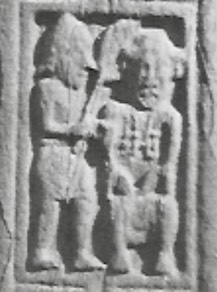
In the photo to the right Cain stands on the left with Abel, seeming to sit, on the right. Cain holds a club and the indication is that he is striking his brother.
This is the first murder recorded in the Hebrew scriptures. Terence E. Fretheim, author of a commentary on The Book of Genesis suggests that this scripture can be seen as pointing to the crucifixion. He writes: “Cains’s feelings or actions are not directed toward God, the one who made the decision (not to honor Cain’s offering) but misdirected toward Abel. In effect, Abel becomes a scapegoat, the one who takes the blame for something God did. . . . The suffering and death of Jesus, who takes on himself the violence and blame for something human beings have done, can be helpfully related to this text.” (Fretheim, p. 376)
In the translation of the Hebrew scriptures from Hebrew to Greek, some liberties were taken in the translation that offered a theological interpretation of the text that made Abel “righteous” and Cain “wicked.” This was picked up by the writers of the Christian scriptures and the interpretation of this story in the early church. (Thatcher, p. 733) This led to a number of possible uses of the text.
a. Abel could be seen as a “prototypical Christian, who suffered only because his ‘offering’ (faith in Christ) was acceptable to God.” This allowed orthodox Christians to identify themselves with Abel and those who disagreed with them with Cain. (Thatcher, p. 741)
b. Cain could represent those who rejected God’s commands. This could apply to “non believing Jews, pagan oppressors, or former Christians who had fallen into perceived apostasy.” (Thatcher, p. 741)
c. The sacrifice of Cain came to be seen as rejected because of “ritual irregularities.” This could be used to reject the Jewish and pagan sacrificial systems. Abel’s sacrifice came to represent the body of Jesus and hence the crucifixion and resurrection. Those with heterodox beliefs could be condemned. (Thatcher, pp. 741-2)
d. The murder of Abel by Cain could be related to the persecution of the Church, whether by the synagogue or the state. This allowed doctrine to become absolute.
In the Book of Hebrews, Jesus, like Abel and the reader of Hebrews, suffered innocently at the hands of those rejected him. (Thatcher, p. 745)
Reflection
Have you ever been given the blame for something someone else did? How did you feel? How did you respond? Do you relate more with Cain or with Abel? Given the variety of possible applications of this story, can you recall times when you have seen any of these used in your life or the life of the church?
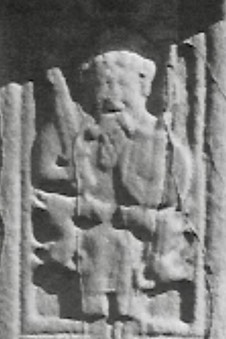
S 3: David as King
Text: 2 Samuel 5:1-3
In the photo to the right above, King David is seated and depicted frontally. He holds a sword in his right hand and a shield in his left. On each side of him there is a dog with its head in his lap. The dogs seem to stand on the walls.
Images from the David Cycle had special meaning to the Irish monks as the Psalms were a part of their daily worship. In addition, because David was seen as the founder of the family of Christ, images from the David Cycle could also be interpreted as precursors of Christ.
Themes of the South Side
It is possible to interpret the south side of the Durrow cross as lifting up human need and God’s gracious response. The image of Adam and Eve eating the fruit outlines the problem of sin and human separation from God. The image of Cain killing Abel can be seen as a parallel to the crucifixion, the death of an innocent victim that brings forgiveness. The image of David as king prefigures Christ and underlines the importance of Christ as God’s answer to the problem of sin.
West Face
Before examining the images on this face of the cross, it is worth noting that all but one of them come directly from the Passion Narratives. They are not depicted in a chronological order, but cover many of the most important events of the Passion.
W 1: Christ in the Tomb

Text: Peter Harbison quotes a passage from the Gospel of Peter IX-X in reference to this image. The Gospels of Matthew and Mark briefly narrate the burial of Jesus. Mark 15:46 “Then Joseph bought a linen cloth, and taking down the body, wrapped it in the linen cloth, and laid it in a tomb that had been hewn out of the rock. He then rolled a stone against the door of the tomb.” The canonical Gospels later narrate the aftermath of the resurrection, the empty tomb. By contrast the Gospel of Peter narrates two men, presumably angels, entering the tomb and three figures leaving the tomb, the central figure being the Risen Christ. (See the box below for the text. Harbison 1992, pp. 287-8)
In the image to the right we see two soldiers leaning together as if asleep or stunned. Each holds a spear. They represent the guards that were assigned to watch the tomb. They sit on a slab of stone that is intended to represent the tomb. The body of Christ is below this, wrapped in a shroud. The stone does not, however, cover his head. Behind the lefthand guard there is a bird. It’s beak extends toward the mouth of Christ, or where his mouth would have been if the stone had not been partly broken. This suggests the presence of the Holy Spirit about to breath the breath of life into the body of Christ. There is a figure between the soldiers that cannot be easily identified. I suggest it may represent at least one of the two angels who are reported in scripture. The image, depicted in this way does not exactly parallel either the descriptions in the canonical Gospels or that of the Gospel of Peter.
In this image, we are dealing with the end of Holy Week, the day of Resurrection. While this image is typically described as “Christ in the Tomb,” it also proclaims the impending resurrection and is thus a clear proclamation of the victory of Christ over death.
Reflection
How do you understand the resurrection? Do you experience the Risen Christ in your life? In what ways?
W 2: The First Mocking or Flagellation of Christ
Text: Mark 14:65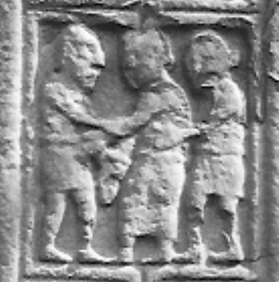
In the image to the right the figure of Jesus is in the center. His hands are tied and he is placed between two figures who seem to hold him. These figures are the guards mentioned in verse 65. In scripture there are two separate mockings or flagellations. The first is by the Jews, the second is by Pilate’s soldiers. This image is interpreted as an example of the first.
This is one of several key events during Holy Week. It took place at the end of the trial of Jesus before the Sanhedrin.
How do we understand the message of this image and the scripture it represents? Pheme Perkins, author of a commentary on the Gospel of Mark, has noted that “After condemning Jesus to death, members of the group subject him to torture. Spitting and scourging continue the affliction of Jesus as righteous sufferer.” (Perkins, p. 714) The innocent one is rejected, condemned and abused by the religious leaders of his own people. The focus here, throughout the past 2000 years, is on Jesus as the innocent, righteous sufferer, whose suffering brings healing to the world.
Reflection
We are called to be mindful that there are many innocent sufferers in our world today. We are called by Jesus, the righteous sufferer, to be concerned for them. What are some of your concerns for innocent sufferers.
W 3: The Soldiers Cast Lots for Christ’s Garments
Text: John 19:23-24
In the image to the right we see three soldiers. The soldier in the center faces frontally and appears to hold the garment of Jesus. The soldiers on the sides are in profile and face the one in the center. Each holds a sword over his shoulder.
This image points to a brief story found in all four of the canonical Gospels. It refers to a custom that allowed the executioners to divide the spoils, typically the garments of the condemned. This passage, in John, quotes a passage from Psalm 22:18 that came to be seen as a prophesy of this event. Thus, the image points to the fulfillment of scripture in the death of Jesus. As Gail R. O’Day notes in a commentary on the Gospel of John, “Even in something as mundane as the disposition of Jesus’ clothes, God’s plan for salvation is at work.” (O’Day, p. 831)
The inclusion of such a small detail of the crucifixion process reminds us that in his crucifixion, Jesus was first abused physically and then stripped of all his possessions and dignity.
Reflection
What has been stripped from you? How did you respond? What do your possessions mean to you?
Head: Center; The Crucifixion
Text: John 19:28-34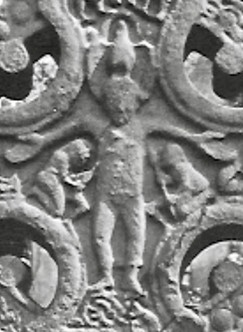
The image to the right is a composite image. That is, it depicts a series of events that were not simultaneous. First, Jesus is crucified, later the figure to the left of Jesus and under his arm offers vinegar on a sponge. (This figure is traditionally known as Stephaton). Then Jesus speaks and dies. Later, the figure on the right of Jesus stabs him with a spear. (This figure is known as Longinus.) Above the head of Jesus is the figure of a dove, representing the presence of the Holy Spirit. As is typical of the Irish High Cross crucifixion scenes, Christ does not appear to be dead. This suggests the image also looks forward to the victory of Christ over death.
Reflection
What part of this composite scene stands out for you? Is it an act of compassion, a further abuse, the presence of the Holy Spirit, the promise of resurrection, or something else?
North Arm: The Denial of Peter
Text: Luke 22:54-62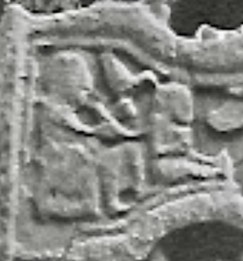
In the image to the right we see the figure of Peter seated on the left. He seems to hold a drinking horn in his right hand and on his left hand is a cock. This clearly identifies this as an image of the Denial of Peter. The figure in front of Peter may represent the second disciple mentioned in John 18:15.
This text has several levels of meaning. Following up on Mark’s emphasis on the weakness of the disciples, Peter is found to be weak. Yet, unlike Jesus’ opponents, Peter is brought to awareness of his weakness by the crowing of the rooster. At the same time, this text reminds us of a prophesy offered in Mark 14:30, during the last supper, where Jesus tells Peter he will deny him. The righteous sufferer experiences the rejection and abandonment of his friends.
Fear and repeated hostile questions overwhelm Peter. This has happened to many of us. As Pheme Perkins wrote, “Christians may stand by and let others be subject to the verbal abuse of racism, sexism, or other forms of injustice. They may let others mock religious belief in their presence without responding. Such polite silences may do more to destroy the possibility of faith for others than Peter’s denials in the high priest’s courtyard.” (Perkins, p. 716)
Reflection
What are some times when, because of fear, you have been silent? Who has your silence wounded, other than yourself?
South Arm: Pilate Washes His Hands
Text: Matthew 27:24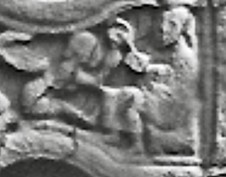
In the image to the right we have Pilate on the right, sitting in a chair. In front of him is a servant who is pouring out water for Pilate to wash his hands.
This image points to a series of events that culminate in Jesus being condemned to death by the political elite of Rome as well as the religious elite of Jerusalem. Even Pilate, who declares that Jesus is innocent accedes to the demands of the religious leaders and turn over Jesus, the righteous sufferer, for more abuse and ultimately death.
This story has a complex history that has sometimes taken a clearly anti-Jewish turn. It has been used to declare the guilt of the Jewish people and the innocence of Rome. But a deeper truth may be that, like Peter, Pilate reacts out of fear. His fear of a riot that might lead to greater violence. His fear of having to answer to the emperor in Rome. His fear about job security and loss of power. Throughout history there have been times when leaders in responsible positions turned a blind eye or tried to wash their hands of responsibility and allowed injustice to prevail.
While the crucifixion takes center stage in Holy Week, as well it should, the suffering of Jesus at the hands of his opponents started the moment he was arrested and continued right up to his death on the cross. Like us, the innocent and righteous continues to suffer. The only word of hope is yet to be seen, on the third day, the day of Resurrection.
Reflection
To what extend has peer pressure or the bias of the crowd caused you to act in unjust ways? What price are you willing to pay for acting against the pressure of others?
Top: Traditio Clavium et Legis
Text: There is no scripture that describes the scene in this image. However, in Matthew 16:19 Jesus promises to give Peter the “keys to the kingdom.” 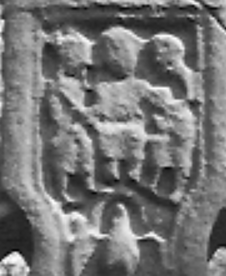
In the image to the right Christ is pictured in the center and appears to be seated. On the left is the figure of St. Peter. To him Christ gives the key to the kingdom. To the right is the figure of St. Paul. To him Christ gives a book, representative of the Gospels.
While not an event from Passion Week and the Resurrection, this event, like the Mission of the Apostles on the East face of the cross points to the ongoing presence of the Risen Christ and of the continuation of his work through his followers. Peter was clearly the leader of the Apostles. Paul was the one primarily responsible for taking the Good News of Christ to the gentile world. The church gave special honor to these two men.
Reflection
Who are some of the people who have deeply influenced your life? Who offers an example to you of how to live lovingly and faithfully?
Themes of the West Face
As noted above, this face of the Durrow cross is almost exclusively a record of major events of the Passion narrative. The one exception is the image of the Traditio Legis et Clavium at the top of the cross shaft. If we arrange the other images in chronological order, we have:
1. The First Mocking or Flagellation of Christ
2. The Denial of Christ by Peter
3. Pilate Washes His Hands
4. The Soldiers Cast Lots for Christ’s Garments
5. The Crucifixion
a. Stephaton offers vinegar on a sponge and Jesus’ last words.
b. Longinus stabs Jesus in the side
6. Christ in the Tomb and the eminent resurrection
7. We then have the non-biblical image of the Traditio Legis et Clavium
Some interpretations have been offered above for each of these individual images. Taken together they represent the rejection and suffering of Christ, the falling away of his disciples and his ultimate victory over death, followed by the spreading of his Gospel throughout the world.
Excursus on Traditio Legis et Clavium
Armin Bergmeier, author of The Traditio Legis in Late Antiquity and Its Afterlives in the Middle Ages, writes that in the context of late Antiquity the Traditio Legis was thought of in relationship to a prophecy from Isaiah 2:2-4. By interpretation, this passage was related to the coming of the Messiah and the spreading of his “Law,” (the New Covenant) around the world. (Bergmeier, p. 27)
“It is not until the Carolingian era that we can be certain that new readings were attached to the traditio legis. . . The medieval examples show that the traditio legis had largely shed its original significance as an image of Isaiah 2:2-4 in favor of a new set of interpretations more relevant to the concerns of a later time. These include the investitures of Peter and Paul, eschatology, and the mission of the apostles, although rarely does one image represent all three themes at once. (Bergmeier p. 42)
The images we have on the Irish High Crosses combine two ideas, the traditio legis et clavium or the giving of the new law to St. Paul, represented by the book of the Gospels and the giving of the keys to the kingdom to St. Peter. This shifts the focus of the image from a triumphant Christ to the handing of objects to the apostles. (Bergmeier p. 47)
The images on the Irish High Crosses can be interpreted as related to the investiture of Peter and Paul in the sense that they were both raised up by the church as the two principle apostles. It can also be interpreted as related to the mission of the apostles as through the ministries of Peter and Paul the spread of the Gospel across the world is highlighted. This interpretation is not far from the interpretation of late Antiquity that related this image to Isaiah 2:2-4 and the coming of all nations to the new law of the Messiah. There is an eschatological element in the interpretation because Peter holds the keys to the kingdom of God and Paul holds the Gospels that lay out the requirements of the New Covenant.
North Side:
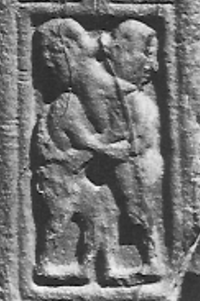
N 1, (?) Saint John the Baptist Embracing/Recognizing Christ;
Text: Scripture does not report an embrace between St. John and Jesus. Matthew 3:13 and similar texts in Mark and Luke record Jesus coming to be baptized by John at the Jordan. In the Gospel of John 1:29, John recognizing Jesus as the Lamb of God.
In the image to the right, lower panel, we see two standing figures leaning together. Given the context in which this image appears, with the other panel on this side of the cross appearing to represent John the Baptist and his parents, the natural interpretation is that this image may also represent a story from the life of John the Baptist. The apparent clothing, especially of the figure on the left, appears to support this. He seems to be clothed in a garment of camel’s hair with his shoulders bare.
The image may represent the familial connection between Jesus and John the Baptist. It may also symbolize John’s recognition of Jesus as the one coming after him, who was greater than him. The meaning of this image is unclear if we accept the alternative identification that this represents Jacob wrestling with the angel.
Reflection
How important are family ties to you? Beyond family, who are the people you greet with a hug or embrace?
N 3, Zacharias and Elizabeth with the Infant John the Baptist
Text: Luke 1:57-64
In the image to the right, upper panel, the figure on the left is a woman with plaited hair who is carrying a child in her left arm. Behind her is the figure of a man who has his left hand up to his mouth. The scripture that most clearly fits this depiction is the text noted above where Elizabeth, the mother of John the Baptist, and her husband Zacharias, the father of John the Baptist, bring John to be circumcised and named. Zacharias was mute until he confirmed in writing that his son should be named John. The hand to the mouth of the right figure strongly suggests this interpretation of the panel.
This image implies the fulfillment of the prophesy proclaimed by the angel Gabriel in Luke 1:11-13. The angel tells Zechariah his wife will conceive and bear a son and that the son shall be named John. Zechariah is unbelieving and Gabriel tells him he will be unable to speak until the birth, and as we learn, the circumcision of the child. When Zechariah fulfills the prophesy by declaring, in writing, that the child is to be named John, he is able to speak again.
Reflection
What is the meaning of baby dedications or baptism to you? If you were dedicated, or baptized as an infant, is that part of your family story, something you were told about as you grew older?
Themes of the North Side
The north side of the cross highlights John the Baptist. His birth, the subject of the upper panel connects him with the birth of Jesus. In the Gospel of Luke the stories of Elizabeth’s pregnancy and the birth of John parallels Mary’s pregnancy and the birth of Jesus. Thus, the birth of John points to the birth of Jesus. The dedication of John in the temple also parallels the dedication of Jesus. The lower panel points to the meeting of John the Baptist and Jesus that just precedes the baptism of Jesus. The baptism, with the appearance of the Spirit, points to one of the central sacraments of the church.
The importance of John the Baptist in a monastic context reminds us that St. Jerome saw John as the precursor of the eremitical life of the monk. In an Irish context, John was venerated as the model of the ascetic life of the monk.
The Iconographic Program of the Cross
In assessing the iconographic program of the entire Durrow cross, we might begin on the South side. Here, as has been noted above, we have the introduction of the problem of sin that effects the entire human family. We can see the image of Cain killing Abel as the death of the innocent victim that brings salvation and the image of David as king looking forward to God’s answer to the problem of sin in Jesus the Christ. If so, this side of the cross offers a thumbnail of salvation history.
We move then to the north side of the cross where the birth and ministry of John the Baptist is outlined. The birth of John is paralleled with the birth of Jesus and prefigures it. His mission of baptism introduces the sacrament or rite that is one of the two most central to the Christian community. There is an extra bonus here in that John the Baptist was so important in the life of the Irish monks.
When we come to the West face of the cross we enter into the Passion and Resurrection narratives. Step by step we are reminded of six important events that run from Maundy Thursday to Resurrection morning. These events tell of the rejection and suffering of Christ, the falling away of his followers and then point to Christ’s victory over death in his resurrection. As a bonus, at the top of the shaft we are reminded that the Risen Christ sends out Peter and Paul to continue to share the Good News.
The East side of the cross can be read as representing the resurrection and authority of Christ. In the Mission to the Apostles, the Risen Christ begins addressing the apostles by saying “All authority in heaven and on earth has been given to me.” His instructions to his apostles are given as an expression of this authority, which he has as a result of his crucifixion and resurrection. The image of the Sacrifice of Isaac higher on the shaft underlines the reality of the cross while also pointing to the resurrection. When Jesus laid down his life, he received it back through resurrection and gained “all authority.” These first two images point to the image in the center of the head of the cross of the Last Judgment. It is the Risen Christ, the Lamb of God, exercising his authority who will, in the words of Matthew 25:31-45, separate the sheep and the goats. The images of David on the arms of the east face also point to the authority of Christ. The David who enters the court of Saul has already been anointed by Samuel. The David who claims to have killed a lion saves the Hebrew people from their enemies. David prefigures the authority of the Christ.
Bibliography
Bergmeier, Armin, The Traditio Legis in Late Antiquity and Its Afterlives in the Middle Ages, in: Gesta 56.1 (2017): 27-52 https://www.academia.edu/32474965/The_Traditio_Legis_in_Late_Antiquity_and_Its_Afterlives_in_the_Middle_Ages_in_Gesta_56_1_2017_27_52
Boring, M. Eugene, The Gospel of Matthew, The New Interpreter’s Bible, Vol. 8, Abingdon Press, 1995.
Fretheim, Terence E., The Book of Genesis, The New Interpreter’s Bible, Vol. 1, Abingdon Press, 1994.
Harbison, Peter; "The High Crosses of Ireland: An Iconographical and Photographic Survey", Dr. Rudolf Habelt GMBH, Bonn, 1992. Volume 1: Text, Volume 2: Photographic Survey; Volume 3: Illustrations of Comparative Iconography.
Henry, Francoise; "Irish High Crosses", Three Candles LTD., Dublin, 1964.
Perkins, Pheme, The Gospel of Mark, The New Interpreter’s Bible, Vol. VIII, Abingdon Press, 1995.
Thatcher, Tom, “Cain and Abel in Early Christian Memory: A Case Study in "The Use of the Old Testament in the New,” The Catholic Biblical Quarterly , October 2010, Vol. 72, No. 4 (October 2010), pp. 732-751